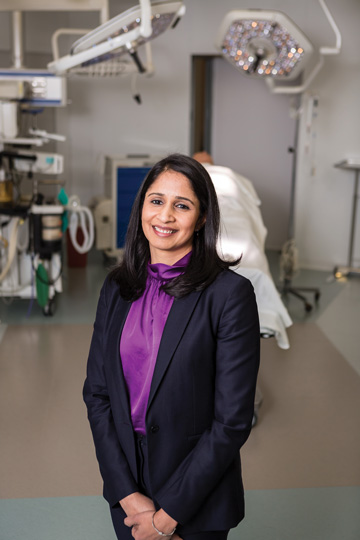- Home
- Article
To Optimize OR Design, Put People First
By: Anjali Joseph, PhD, EDAC
Published: 4/15/2024
Human-centered elements that focus on patients and staff lead to safer spaces and better outcomes.
Through my decades of researching, testing and helping implement healthcare design solutions, I’ve learned an important lesson: A human-centered and evidence-based approach, particularly in highly complex surgical care environments, can simultaneously optimize efficiency, team satisfaction and patient safety.
As part of our five-year project to test human-centered OR design through our Patient Safety Learning Lab at Clemson (S.C.) University, we obtained an in-depth understanding of the work of surgical teams, as well as related patient safety and workflow challenges, by observing these teams in practice, scouring the literature and visiting best-practice facilities. In response to those findings, we developed innovative, evidence-based OR design ideas through physical and virtual mock-ups, and then implemented them in working ORs. Here’s what we found.
The appeal of human-centered design
The best OR design centers on a high-functioning, well-organized space with adequate room to move, efficient access to supplies and the patient, and as little clutter as possible to reduce trip hazards and harbors for infectious diseases. It’s even better when this space supports the health of staff by providing access to natural light during their workday. These design elements enable high-functioning surgical teams to work more collaboratively and efficiently.
However, creating this ideal setting is not always simple. Ongoing technological and procedural developments are bringing more equipment into ORs that is not designed to support these changes and additions to staff workflow. Ever-evolving infectious diseases create risks for surface and air contamination that can infect surgical sites and create negative postsurgical outcomes, while staff and surgeons can feel increased mental and physical strain. These challenges further reinforce the need for an approach that supports and equips staff to do their best work. A human-centered OR removes unnecessary challenges and barriers posed by the physical environment that contribute to additional burden for staff.
Human-centered design also capitalizes on our best design resource — the people who work in these spaces. The evidence shows us that a creative and collaborative design approach is the best way to optimize new and existing surgical spaces.
Four elements of human-centered design

As I look five, 10, even 20 years into the future of surgery center design, I believe these four elements will make significant, long-lasting, positive impacts on surgical teams and their patients.
1. Safe movement
Through observing OR activities and studying the literature, we’ve found common design flaws that contribute to errors. These include frequent door openings, excessive movements in the OR, and constricted space around the surgical table. We designed changes to address these flaws, such as:
• Overhead booms that reduce floor clutter. Leveraging vertical floor-to-ceiling space with overhead booms gives teams more flexibility to move equipment when needed while minimizing horizontal surfaces that can harbor infectious contaminants. Overhead booms also reduce clutter, wires and trip hazards on the floor. Beyond lighting, booms can house imaging technology and even staff-specific tools to reduce workflow disruptions. For example, one of our design solutions creates an anesthesia workstation connected to a boom from the ceiling to give the anesthesia provider more flexibility in workstation placement and closer proximity to the patient without conflicting with the surgeon.
• Angled surgical table placement that delineates functional zones and improves patient access for different team members and surgeries. This strategy also opens space in the high-traffic area at the foot of the surgical table, which results in fewer bumps and disruptions as team members move around from the patient to supplies on the back table. One real-world example of this strategy’s efficacy: incorporating an angled surgical table footprint into OR floor design has helped outpatient orthopedic surgical teams at Emory Musculoskeletal Institute in Brookhaven, Ga., achieve more efficient workflows.
• Strategically placed storage that reduces unnecessary traffic. Storage space should be located adjacent to team member locations to reduce the number of steps needed to retrieve supplies. For example, creating a space for supply storage near the circulating nurse’s workspace reduces their steps back and forth across the room. By reducing movement, well-considered integrated storage also reduces disruptions within the OR, which in turn reduces airborne microbial load and contamination within the OR that can lead to surgical site infections.
• Stainless steel modular wall panels that allow for space reconfiguration. As more procedures move to outpatient care, the technologies needed to perform them will need to be incorporated into surgical spaces. While a trend toward more minimally invasive procedures means much of this technology is compact, that’s not always the case. For example, surgical robots still require significant footprints and unique setups to position the surgeon’s console. ORs with modular configurations greatly increase positioning flexibility and can be changed whenever needed.
2. Virtual technology
Our research has identified how simulating surgical procedures within a physical mock-up of a proposed OR design gives teams a chance to explore new surgical spaces together in the context of their everyday work. They can also troubleshoot design flaws that can be resolved long before construction. Using virtual and augmented reality technology for OR design exploration enables these evaluations to be performed more quickly and inexpensively. This technology enables teams to explore design elements such as room size and proportions, configuration of zones and sightlines for visual displays around overhead booms. Currently, many affordable VR headsets allow you to superimpose a virtual environment onto a physical space and move objects around as you would in a real space. As this technology evolves, I can see a point in the near future where designers and clinicians can evaluate virtual designs together. I recommend using a standardized evaluation tool such as the one we created (osmag.net/standardize) to ensure key design elements work.

Dr. Joseph and design colleagues from Clemson University recently presented a webinar on “Operating Room Design: Using an Evidence-Based Design Process” for the American Institute of Architects Academy of Architecture for Health. They provided an overview of their research process for developing concepts for flexible and safe OR layouts and shared how their findings were implemented in real-world settings at the Medical University of South Carolina and Emory Musculoskeletal Institute. AORN’s recently updated “Guideline for Design and Maintenance of the Surgical Suite” provides important evidence-based considerations and regulatory requirements for building or remodeling all surgical spaces, including outpatient surgery centers. Subscribers can access the guideline and complementary implementation tools at aornguidelines.org.
—Carina Stanton
3. Patient experience
The post-COVID-19 push of elective surgeries to outpatient settings continues to be a preference for some large health systems that are building one-stop care locations in communities. These centers allow a patient to visit their physician’s office, receive preoperative testing or scans and get their surgery all in one space. I predict this all-in-one care experience will influence new outpatient and freestanding surgical center designs long-term.
Optimization of the patient experience is shaping outpatient care design. This starts with nonclinical spaces. The moment a patient arrives at a surgery center, they need warm and welcoming access for registration and more private spaces to be with loved ones. Sterile waiting rooms that feel like airport lounges are giving way to more comfortable furnishings, softer lighting, grouped seating areas and even scenic views if possible. Reducing wait times is another patient experience imperative. Apps that enable patients to check in before their arrival and telehealth encounters for pre- and post-surgical care support this goal.
4. Staff comfort
COVID-19 also influenced healthcare design in terms of a greater awareness of the burdens such as unsafe ergonomics that can contribute to clinician burnout. While it remains important to design break areas for providers, we now also recognize that preventing burnout can start with optimizing work areas in the OR to reduce physical strain and cognitive burden.
Through my work with the American College of Surgeons, we investigated how to integrate safer ergonomics into the built environment and practices that leverage these built-in safety measures. For example, we recommend placing a display monitor directly in front of a user to reduce neck and eye strain. Specific to user height, the upper edge of the display should be at eye level and the center of the screen should be slightly below eye level. Housing displays on adjustable overhead booms makes it easier for teams to perform ergonomic adjustments for individuals of various heights. We also considered ergonomics for the surgeon console in robotic surgeries by recommending an adjustment of the viewer height, so the provider maintains a neutral neck posture without slouching their back. These recommendations reinforce the importance of adjustment functionality in a design space. Helping teams understand how and why they should make these ergonomic adjustments will reduce their discomfort and injury risk.
How outpatient design can lead
Our environment has great capacity to heal and uplift. As we look to the future of healthcare design, a human-centered approach will enable facilities and their teams to shape and then constantly adapt their built surgical spaces. I believe outpatient and freestanding care centers will lead this focus on design.
It is important to embrace these lessons, no matter if you are a physician just beginning your journey to build a freestanding surgical center or a major multicampus academic center exploring options to provide surgical care to outlying areas. I encourage every design team to put staff, patients and the broader community at the center of their facility design projects. Think outside the box to understand and then design what patients and staff need most to create ongoing, positive and healthy care encounters. OSM
.svg?sfvrsn=be606e78_3)
.svg?sfvrsn=56b2f850_5)